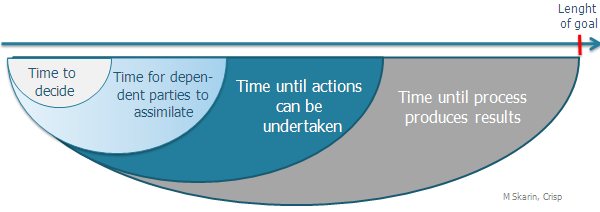If we set the decision lenght of a goal too far – the goals will be eaten up by the imminent future and risk lose focus.
If the set the decision lenght too short, we risk "decision thrashing" (organisation loses faith in leadership because of constant change in direction, seemingly without thought). An example would be changing strategy more often than the strategy can be implemented.
So it is very important we set the goal horizon to a periodicity which allows organisation understand, assimliate and produce results.
Meeting a senior management member from Volvo brought this issue to light for me many years ago.
"How long time does it take when top managment changes strategy from the decision until the shop floor worker understand what it means in his daily work?" – he asked.
"I don’t know" – I replied.
"Three years" – he replied.





In this blog post you summarize how efficient decision making should be done in general forms. I think you really succeeded in creating a good and concise post. I like it and I like the term “decision thrashing”!
This post also makes me think of how the human psychology works. Usually when a person makes a decision to change behaviour it takes about three month before the decision has anchor to a new behaviour/habit. It’s an interesting parallel. It takes three month for an individual to change behaviour and three years for an organization.
Back in school i was teached that it takes 3 years from a reorganisation until you get a possitive effect and therefore most organisations changes boss/reorganise each 3 year so you never see the effect of the changes.
Yes and in this fact management is truly broken. A piece of the responsibility falls on our training systems and (MBA) schools fanatically pursing scientific management and control my part instead of optimizing the whole.